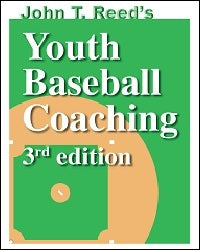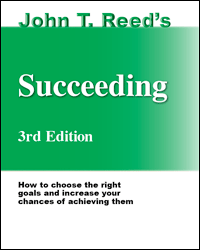The pitcher-cover-first play
Posted by John Reed on
One of the recurring themes in my how-to books is there are a lot of things in life that can be accomplished by everyone—no talent required—but most people can’t do them because they take the attitude that since everyone can do it, no one need practice it.
That’s wrong. And in many cases, the number of practice repetitions needed is minimal. For example, in football, if you give your kick returners practice giving the fair-catch signal, they will learn it in only about two or three repetitions. But if you give them NO practice reps, they will probably screw it up when the need arises in a game.
Baseball season is upon us and I wrote two books about how to coach that sport. One of the chapters in those books is titled “Pitcher fielding” and one of the main fielding plays pitchers need to learn is the pitcher-cover-first play.
One of the chapters in those books is titled “Pitcher fielding” and one of the main fielding plays pitchers need to learn is the pitcher-cover-first play.
Once in a game where I was the manager of a minors team that my youngest son was on, there was a majors manager sitting in our dugout during the game. We ran a perfect pitcher-cover-first play in the game. I commented “We are the only team in this league that can run that play.” The majors [a higher level of talent] manager added, “No one at the majors level can run it either” including his own team.
Just 3 or 4 reps
So what’s the trick? You need to teach your pitchers and first basemen the mechanics of it and give them enough reps of it. How many? I’d say each player needs about 3 or 4 reps initially. Then we made that play part of our pre-game “hit infield.”
Most teams just hit infield to the three basemen and the shortstop. We also line up all the pitchers at the mound and all the first basemen at first and give each one rep of the play before each game.
Ground ball to the pitcher’s left
The mechanics are these: Whenever a ground ball is hit to the pitcher’s left, he must instantly execute the pitcher-cover-first play. The first baseman may call him off and just step on the bag himself, but initially the pitcher must assume he will be getting a throw from the first baseman. He does NOT have time to look back and assess whether he will be needed. He must instinctively run to first on all ground balls hit to his left.
To the baseline, not the base
Also, he must run to a spot about two-thirds of the way to first on the first base line, then run parallel to the line toward first. He must NOT run direct from the mound toward first base. I would put a cone or hat or glove on the ground at the 2/3 spot and make the pitcher run around it before heading toward first.
‘First the ball, then the play’
Finally come the eyes. There is an old, important saying in baseball: “first the ball, then the play.” In this case, the pitcher must first watch the ball come into his glove, then and only then may he look for the base to step on it. Running parallel to the baseline makes it easier to be on target to step on the base. It also prevents a collision with the runner if both tried to run across the base. Of course, the first baseman must throw the ball to the pitcher early so he has time to find the base with his eyes after the catch.
Coaches and fathers of pitchers and first basemen, this simple addition to your practices and pre-game warm-ups will make you look like a genius and make your players look and feel like pros. True, the pitcher-cover-first situation only happens about two or three times a season.
But let me tell you what will happen on those two or three times if you do NOT practice this. You first baseman will go field the ground ball. Your pitcher will stay at the mound spectating. And the batter will cruise through an unoccupied first base with an infield hit that should be scored E1, or more fairly: E manager.
Then the adult manager publicly puts the blame on the kid pitcher
After the play ends, the manager publicly chews the players out in front of all the other players and parents. “Why didn’t you go to first base?” the adult manager asks the pitcher loudly, thereby trying to absolve himself of responsibility for the embarrassing screw-up—by throwing the kid under the bus.
I have the answer to why the pitcher did not go to first base. Because the guy asking it did not read my book and follow what it said. And that’s only one part of one chapter.
Play ball.
Life, not just baseball
And remember what I said at the beginning. This is not just a baseball play. It’s an example of a truth about succeeding in life. It’s covered more generically in a chapter in my Succeeding book titled “Mechanical tricks.”
 That chapter says almost everything you do in life is in part made up of learning mechanical tricks that everyone can learn IF THEY MAKE THE RELATIVELY SMALL EFFORT REQUIRED. There is a saying in coaching that “You don’t need talent to hustle.” Learning the mechanical tricks is one crucial form of hustle. And the people who come out of top in life are the ones who combine talent and hustle, not just the ones with talent.
That chapter says almost everything you do in life is in part made up of learning mechanical tricks that everyone can learn IF THEY MAKE THE RELATIVELY SMALL EFFORT REQUIRED. There is a saying in coaching that “You don’t need talent to hustle.” Learning the mechanical tricks is one crucial form of hustle. And the people who come out of top in life are the ones who combine talent and hustle, not just the ones with talent.
Share this post
0 comment
